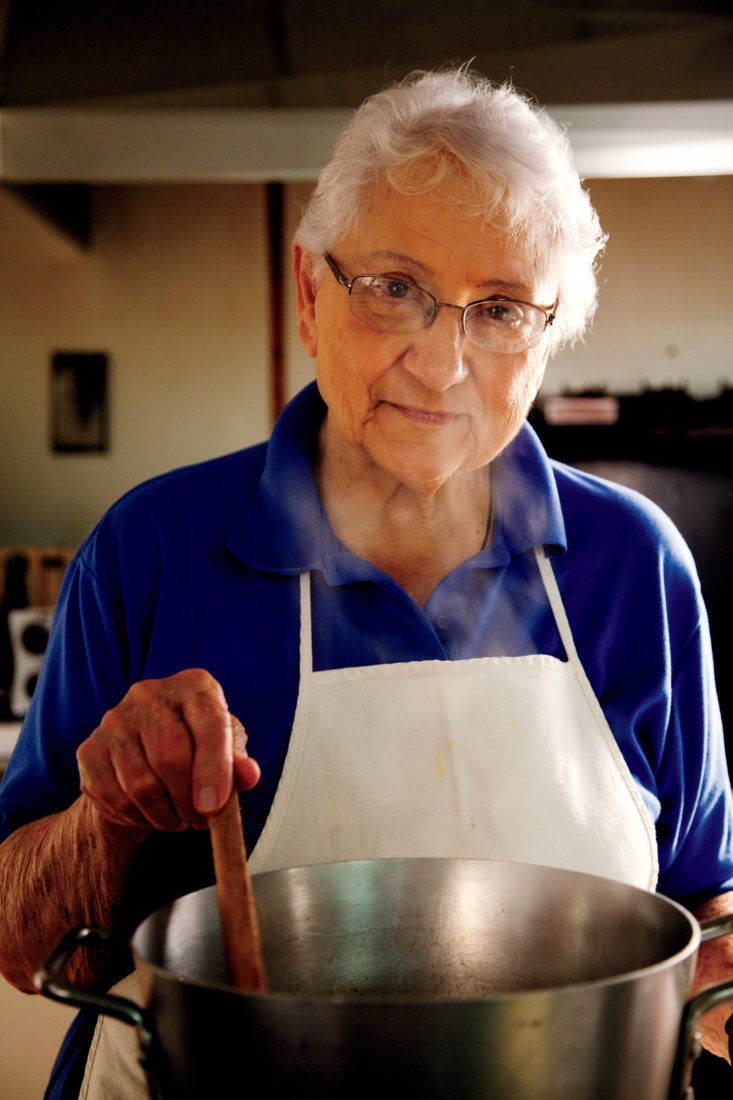In southeastern Louisiana, in a windowless restaurant that was once a welding shop, a diner has left a fervent message for the proprietor, scribbled in the guest book: “God loves Alzina!” The writer may be in a special position to know. After all, Alzina Toups, who attends mass just across Bayou Lafourche at St. Joseph Catholic Church, has cooked for countless priests, nuns, and bishops over the past thirty-five years. Then again, maybe the note’s author just figured that anybody who makes such a heavenly black-eyed pea jambalaya has got to be blessed.
Regardless, many in the oil-and-fishing town of Galliano would most likely agree, because they’ve eaten Alzina’s Cajun food, bought one of her cookbooks, or heard stories about her amaretto yams. Culinary pilgrims from Brooklyn and France have sat at her table. Yet even among eaters an hour and a half north in New Orleans, Alzina’s Kitchen remains relatively unknown.
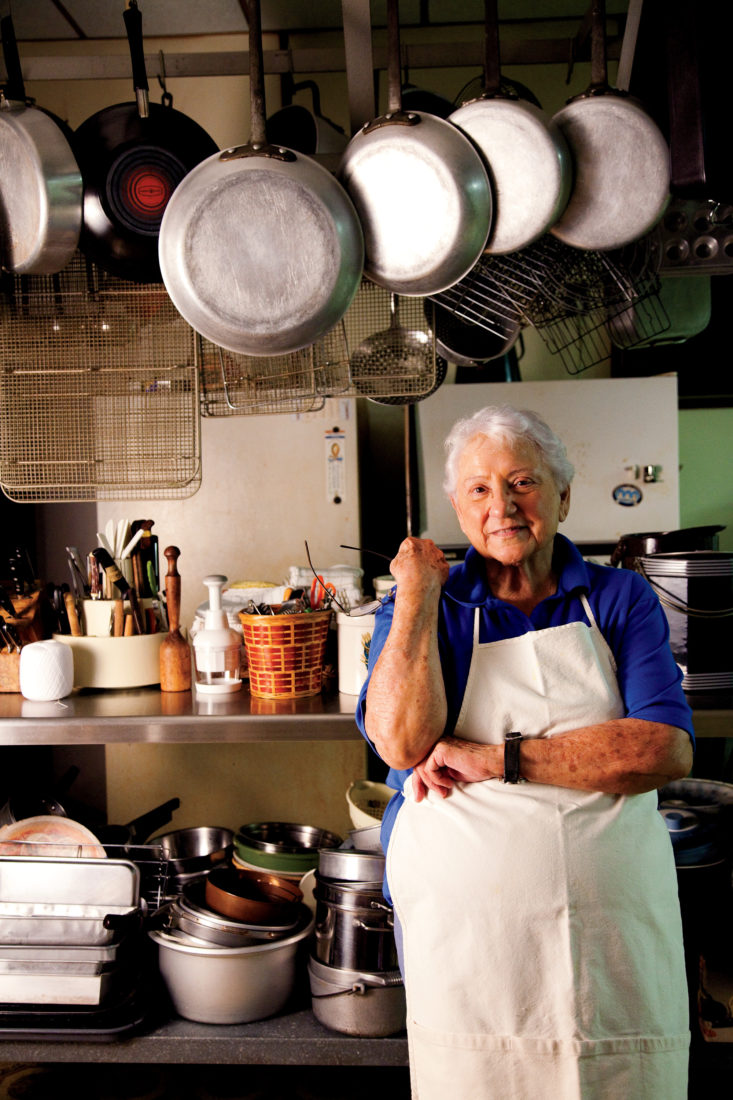
Photo: Cedric Angeles
Alzina presides over her kitchen
Of course, the place is hard to find. The blue letters that once spelled “Alzina’s” have crumbled almost completely off the metal building that houses the restaurant, located on a residential street. There’s no menu on the door, no posted hours. The only signs that food might be ahead are a rusting Ford pickup truck with thyme and garlic chives growing in its bed, and patches of parsley sprouting between cracks in the concrete. She refuses to advertise and cooks only for groups of six or more who reserve at least two weeks in advance.
Inside, Alzina has erased the boundaries between kitchen and dining room, chef and patrons. Customers eat family-style at two long communal tables beneath images of the Virgin Mary and framed menus of grand meals past, and they share the same fluorescent-lit room as sink, stove, and oven. The proximity has inspired diners to volunteer for dish duty after meals. Regulars—and there are many—send cards and letters. One group of bankers ate dinner at Alzina’s once a week for thirty-three years.
“All my people who come here, even the first time, they make themselves at home,” Alzina says in her kitchen on the first day of spring. She’s standing behind pots of slow-cooking green beans and a simmering red sauce that will be served with Gulf shrimp as part of a seven-course lunch. “See this tomato sauce?” she says, offering a spoonful. “It’s perfect. And I don’t put any salt in there because I salt my shrimp. Taste that. It’s good?”
C’est bon, as they say around here—uncomplicated, fresh, and bright—and Cajun in spirit and detail. “Not like in New Orleans,” Alzina says. “In New Orleans, it’s Creole. They use a heavy roux for their gumbo; we don’t use a heavy roux. They use bay leaves in their cabbage; we don’t do that.”
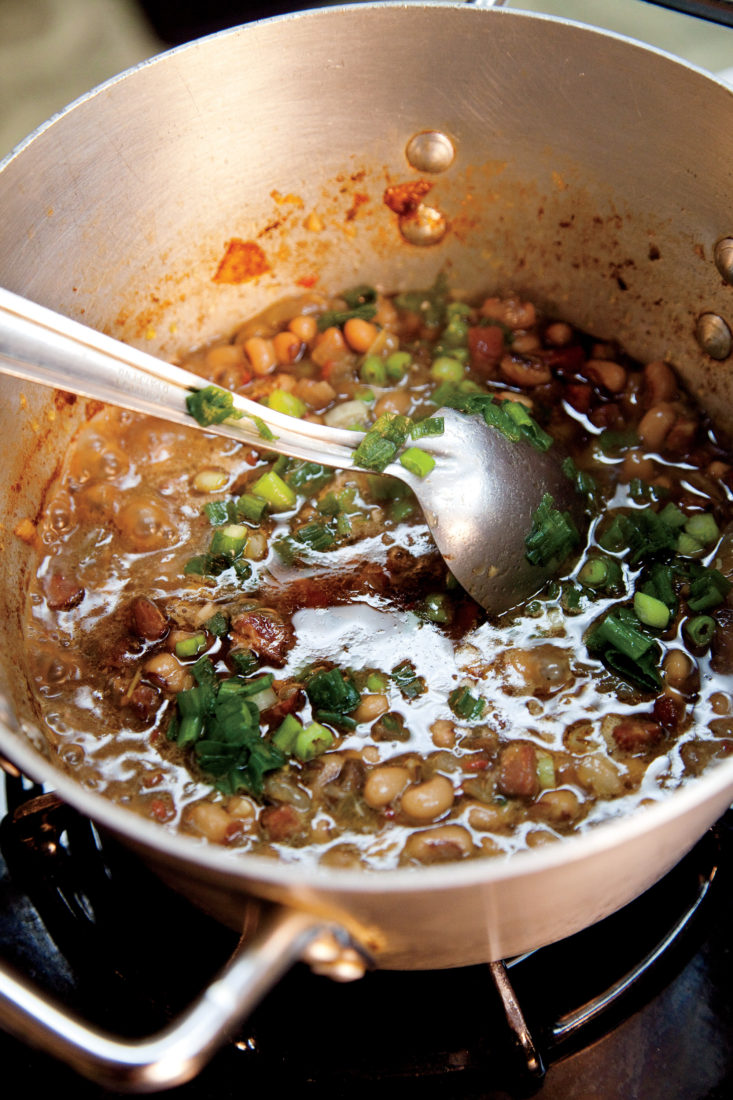
Photo: Cedric Angeles
Cajun black-eyed pea jambalaya simmers on the stove.
Nearly eighty-four, Alzina has the white hair and saintly smile of an old-world grandmother. She’s short and soft-spoken, the gliding vowels of her accent hard to hear over the voices of a granddaughter and four church friends who have come to help. But a woman who can debone a chicken in four minutes does not need to shout. “I can’t do nothing without her supervising,” says her friend Debra Pitre as she waits for Alzina to show her how to slice pears for a salad. “She wants it done her way—and she has her special way.”
Alzina recruited Pitre to her kitchen with a xeroxed copy of a prayer. In turn, Pitre gave her the affectionate nickname of Al “because she orders people around like a man.” Her children call her Chief. She has asked a bishop to kneel and hold a dustpan to expedite cleanup. Regulars know that if they arrive early, they will wait for their meal. “We run out of iced tea?” says another friend, Kathy Sandras. “They’re going to drink water.”
Where a main street would be in any other town, Galliano has a rail-straight stretch of the 110-mile Bayou Lafourche, its calm waters floating trawlers and flanked by highways populated by work trucks and oil tankers. Before dams and levees, this western fork of the Mississippi River routinely flooded surrounding fields as it flowed toward the Gulf of Mexico, making the land particularly fertile for growing sugarcane. Suburbs have swallowed most of those farms, but a few local stores still sell fresh cane syrup.
Alzina grew up in a quieter Galliano, on a little farm with pigs and chickens. Both her father, a Cajun fisherman, and her mother, a Portuguese immigrant, cooked. She has fond memories of their spaghetti and says she can taste her mother’s food to this day. The first part of her adult life was spent on a shrimp boat with her husband, traversing the waters between Texas and the mouth of the Mississippi. That’s where she learned to debone a fish without breaking the skin. “I saw so many things on that boat that no one can take away,” Alzina says. “So many fish, the sunrise, the sunset, the dolphins.”
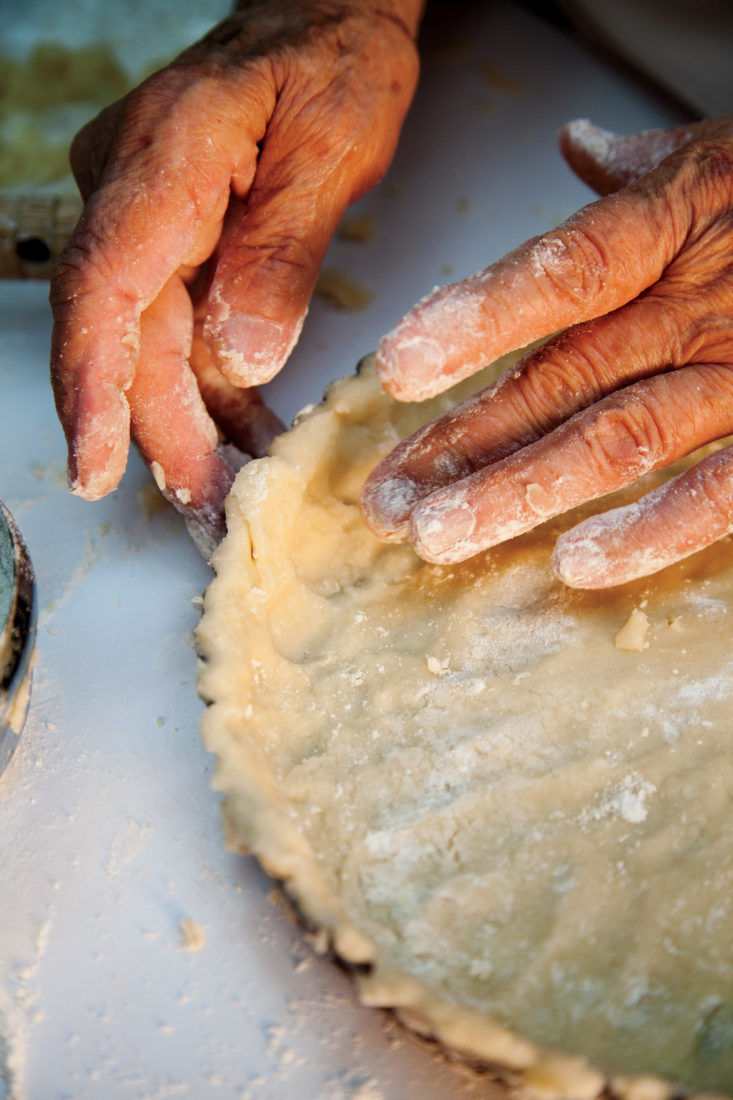
Photo: Cedric Angeles
Floured hands crimp a crust
If Alzina could have her way, she would have been born in the 1800s. Her favorite vacation was lodging with an Amish family in Pennsylvania, where she spent most of her time picking corn and apples. When not in her restaurant, she can usually be found at church or the grocery store, or crocheting at home, in the white cottage where she raised her two sons, just across the street from the restaurant. She refuses to buy a cell phone—“You think I want someone to be calling me when I’m doing something?” Her motto: “Simple life, you happy.”
Which makes sense when you consider Alzina’s food. Even her dried herbs originate in the garden rather than the store, her pasta is handmade, and her produce, shrimp, and crab come from local farms and fishing boats, season permitting. “She’s been doing for the last thirty-five years what all our chefs here have been preaching about for the last ten,” says Ryan Hughes, the chef at Johnny V’s Bistro in New Orleans.
That’s not to say Alzina’s food is unsophisticated. When Hughes, who is classically trained, spoke with Alzina after dinner at her restaurant, he found she knew many of the pastry techniques he’d learned in France. “She was doing the exact same thing,” he says. “She just learned it on her own.” Before Hughes and his sous-chef left for the drive home, she shared her black-eyed pea jambalaya recipe. “I give the chefs my recipes when they come,” Alzina says with a shrug. “We not just running a business here.”
Around noon, the priests file in for lunch. They meet every month to talk church business, rotating from parish to parish. But attendance is usually best in Lafourche Parish because they get to eat a meal at Alzina’s Kitchen: salad with roasted pears tossed with salt and chile flakes; creamed broccoli soup; jambalaya; green beans; fresh lasagna noodles with a crab and shrimp béchamel; a rice-stuffed and roasted chicken leg; and cabbage cooked for hours with pork tenderloin until it’s sweet and silky.
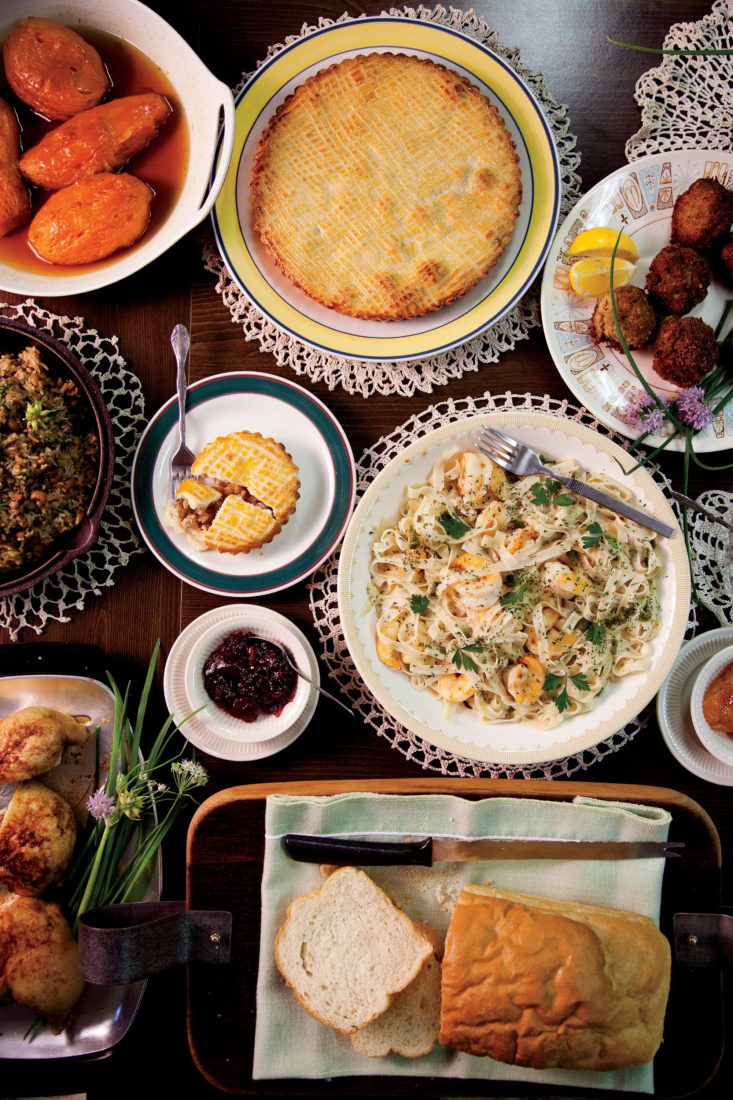
Photo: Cedric Angeles
A recent family-style feast included hand-pulled pasta and amaretto yams.
As the meal progresses, the priests laugh and unsnap their clerical collars. Almost all of them are immigrants—from Malaysia, the Philippines, and Vietnam. In a gesture of gratitude and perhaps wishful thinking, they give Alzina a cookbook titled Homestyle Asian.
“It might be easier than Cajun food,” she says with a grin. “It took me three hours to cook the cabbage!” Yet it’s obvious nobody really wants change. After the meal, Sabino Rebosura, a priest who grew up in the Philippines and works up the bayou at St. Hilary of Poitiers, lingers in the kitchen, packing Cajun leftovers into take-out containers.
He’s wise to seize the day. “You know, I’m getting old,” Alzina had said earlier, leaning against a stool she keeps behind the stove. “I’m going to have to step down.” Six months ago, she had open-heart surgery, and the doctor told her she shouldn’t lift anything heavy—like a pot—for at least a year. She mostly complies, although she was peeling shrimp three weeks after leaving the hospital. Alzina’s granddaughter Jenny Stevens made all the desserts for the priests’ lunch: a lemon roll, golden flan, and an airy cheesecake.
“You did most of it now,” Alzina says, smiling at her granddaughter, a pretty, dark-haired woman wearing a fleur-de-lis pendant.
“No, you did the chicken leg,” Jenny says, referring to the tedium of deboning and stuffing.

Photo: Cedric Angeles
Fresh-from-the-garden herbs make for a simple garnish
If Alzina seems untroubled by her slower pace, it’s most likely because the plan is for her kitchen to eventually become Jenny’s. An avid baker, Jenny wants to renovate and has an idea to turn a neglected back room into a take-out window. She enrolled in culinary school but dropped out when she decided she was learning just as much at her grandmother’s side. “The biggest thing with our food?” Jenny says. “It’s simple ingredients, natural ingredients. Real Cajun food is not spicy. It is not covered in seasoning. Blackened food is not Cajun.”
Jenny and her grandmother’s friends often joke about Alzina’s refusal to throw anything away. They rummage through the kitchen and dig up a fifty-year-old can opener with a wooden handle as proof. Alzina just smiles. She likes to save things she considers important: the receipt from the sale of her father’s boat, the needle with which her mother repaired trawling nets. She has a whole shed full of jars. When she was younger, she preserved green beans, corn, and carrots, and made rose petal jellies. “My granddaughter, she’s going to start canning,” Alzina says. “She can have them all.”


